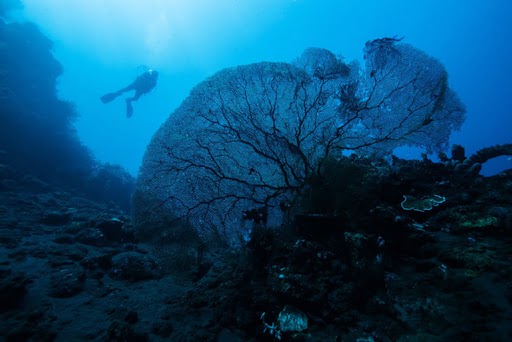The light that penetrates the depths of the ocean differs from the white light that reaches plants on land. Photosynthetic algae have developed unique pigments to capture the sun’s energy at the ocean floor. These pigments, which are red, purple, and brown, are distinct from the green algae found on land and in shallower waters.
It is commonly known that plants are typically green… correct?
In order to perform photosynthesis and produce sugar, plants require chlorophyll, which gives them their green color. However, this is not the case for all plants.
Some of the earliest plants on Earth, known as cyanobacteria or blue-green algae, evolved in the ocean. In this environment, algae developed a wide range of colors, including brown, red, purple, and even fluorescent shades.
So how do these colored algae photosynthesize? And what causes them to be red or brown?
 One example of nature’s fascinating use of light is bioluminescent beaches! (Photo Credit: RugliG/Shutterstock)
One example of nature’s fascinating use of light is bioluminescent beaches! (Photo Credit: RugliG/Shutterstock)
What Determines an Object’s Color?
When light hits an object, it is either reflected or absorbed. The color we see is the color that is reflected.
An object’s color also depends on the colors it absorbs. To illustrate this, let’s consider the leaves of a tree. They appear green because chlorophyll absorbs blue and red light, while reflecting green light.
Similarly, for an object to appear red, like deep-sea algae, it must absorb green and blue light and reflect red light. But why is it necessary for them to absorb blue and green light? The behavior of light passing through water provides an explanation.
Why Does Red Algae Require Blue Light?
In the ocean, water absorbs red light more than any other color, particularly blue light. This is why the ocean appears blue, as the blue light is reflected back.
Therefore, in deep waters, plants can only utilize blue light for photosynthesis. However, regular chlorophyll is not sufficient for this purpose. So what do they use instead?
 In this underwater picture, everything appears blue due to the absorption of red light. (Photo Credit: littlesam/Shutterstock)
In this underwater picture, everything appears blue due to the absorption of red light. (Photo Credit: littlesam/Shutterstock)
Photosynthesis in Deep Waters
Green plants possess two types of chlorophyll: chlorophyll-a, which absorbs blue and orange-yellow light, and chlorophyll-b, which absorbs blue and red light. This leaves the color green in the spectrum.
Surprisingly, red algae contain chlorophyll-a, meaning they absorb blue and orange-yellow light. However, the energy obtained from this is not enough for these plants to produce food.
Instead of chlorophyll-b, red algae have a unique group of pigments called phycoerythrins.
Phycoerythrins are red photosynthetic pigments, deriving their color from absorbing blue and green light.

Isn’t this Red Algae beautiful? Its beauty is all thanks to phycoerythrins! (Photo Credit: Antonio Martin/Shutterstock)
The fact that the pigments are red is not the most fascinating part. Unlike most plants that primarily rely on chlorophyll to capture the sun’s energy, red algae actually utilize phycoerythrins as their main photosynthetic pigments. In fact, according to a study, the amount of phycoerythrin found in these plants can be up to five times greater than chlorophyll.
This also has an intriguing impact on the end product of their photosynthesis.
Different pigments also affect the type of food that red algae can produce. In surface plants, food is stored as starch. Starch is widely known for being abundant in potatoes. Numerous glucose molecules join together in a large chain to form starch granules.
Red algae stores its food as Floridian starch. This particular starch is named after a family of algae found exclusively in Florida, USA. Floridian starch is also a long chain of glucose molecules, but the arrangement of the bonds between the glucose molecules is different.
In conclusion, life on our planet has adapted in various fascinating and unique ways. Red algae is a remarkable example of this. They are able to survive and thrive in seemingly impossible environments.
In their quest to conquer these challenging habitats, they develop incredible adaptations. Our natural world extends far beyond what we can see, and when we venture out to explore it, we uncover many intriguing phenomena, such as plants that are colored red!
